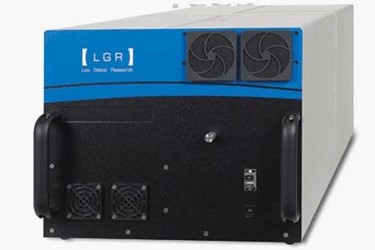Ammonia Analyzer - Trace (NH3)

LGR's new Ammonia Analyzer - Trace (AAT) provides fast measurements of ammonia in ambient air with unparalleled precision, sensitivity and time response. No longer do you have to wait for minutes before getting a reliable reading – LGR’s AAT provides measurements at 10 Hz with sub-ppb precision. In addition, the AAT can report measurements quickly over a wide range of ammonia concentrations.
The analyzer uses LGR’s patented Off-axis ICOS technology, a fourth-generation cavity enhanced absorption technique which employs a high-finesse optical cavity as the measurement cell. LGR’s technology has many proven advantages over conventional first-generation cavity ringdown spectroscopy (CRDS) techniques. In brief, since the laser beam does not have to be resonantly coupled to the measurement cell (i.e. precise beam alignment is not critical), LGR Analyzers are relatively inexpensive, simple to build, and inherently robust thermally and mechanically. In addition, since LGR’s technology can record reliable absorption spectra over a far wider range of optical depths (absorbance values) compared with CRDS, LGR Analyzers provide measurements over a much wider range of mole fractions (gas concentrations). Finally, due to the ease and simplicity of recording and quantifying the measured spectra using LGR’s Off-Axis ICOS, LGR Analyzers display the entire absorption spectra to the user in real time allowing for immediate system diagnostics and performance validation.
The Analyzer has an internal computer (Linux OS) that can store data practically indefinitely on its hard disk drive and send real time data to a data logger via the digital (RS232) or Ethernet outputs. Furthermore, as with all LGR analyzers, this Analyzer may be controlled remotely via the Internet. This capability allows the user to operate the analyzer using a web browser practically anywhere Internet access is available. This remote access allows bios-level control of the instrument and provides the opportunity to obtain data and to diagnose the instrument operation without being on site.
The analyzer uses LGR’s patented Off-axis ICOS technology, the fourth-generation cavity enhanced absorption technique, which employs a high-finesse optical cavity as the measurement cell. LGR’s technology has many proven advantages over conventional first-generation cavity ringdown spectroscopy (CRDS) techniques. In brief, since the laser beam does not have to be resonantly coupled to the measurement cell (i.e. precise beam alignment is not critical), LGR Analyzers are relatively inexpensive, simple to build, and inherently robust thermally and mechanically. In addition, since LGR’s technology can record reliable absorption spectra over a far wider range of optical depths (absorbance values) compared with CRDS, LGR Analyzers provide measurements over a much wider range of mixing ratios (gas concentrations). Finally, due to the ease and simplicity of recording and quantifying the measured spectra using LGR’s Off-Axis ICOS, LGR Analyzers display the entire absorption spectra to the user in real time allowing for immediate system diagnostics and performance validation.
LGR’s new “Enhanced Performance series” incorporates proprietary internal thermal control for ultra-stable, minimal-drift measurements with unsurpassed precision and accuracy.
For customers interested in a less expensive ammonia analyzer with very high precision and fast response time, LGR offers the Economical Ammonia Analyzer in the standard rackmount and ultraportable package styles.
For eddy covariance flux applications, please see: Eddy Covariance Package.
Quite simply, no other analyzer provides higher performance. For more details, please see: advantages.
